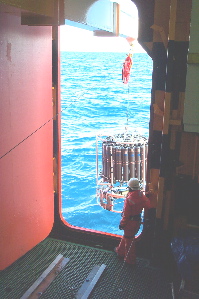The Journey to IVARS Station #1
The first IVARS sampling site lies about 100 miles northwest of McMurdo Station, just outside the point where McMurdo Sound opens into the Ross Sea. To get there, the Palmer must break through about 60 miles of sea ice. The unbroken sea ice averages 3-4 meters (9-12 ft.) thick. We travel through an existing channel that was earlier cut by icebreakers, but the passage is still nearly completely full of car- to house-size chunks of ice that have more or less begun to freeze together again.
We were ushered through the first 20 miles of ice by a Russian icebreaker that came to McMurdo under contract to the NSF.
The channel is usually kept clear by the U.S. Coast Guard Cutter Polar Star,
but that vessel ruptured the hydraulic seal
on its main propeller while breaking ice during the December IVARS
cruise. The sea ice is unusually thick this summer due to the
presence of iceberg B-15a near the mouth of McMurdo Sound.
Breaking through sea ice is neither fast nor quiet. The 308-foot Palmer powers through the ice at about 3 knots, using its 12,720 horsepower main engine, 2 propellers that are each 4 meters (13') in diameter, and bow plates that are 1 1/2" thick and twice as strong as regular steel. The scraping of the ice against the hull generates a constant background rumble that is particularly audible on the lower decks. Contact with the larger bergs makes the whole ship shudder. We occasionally have to stop and back up with the bow thrusters to free the stern propellers of accumulating ice.
The channel attracts animals looking for an easy way to reach open water and the food it holds and acts as a entryway into the sea ice for others. Our passage through the ice is thus marked by small groups of Weddell seals (Leptonychotes weddellii) and Adelie penguins (Pygoscelis adeliae) fleeing the ship's oncoming bulk. Skua birds (Catharacta maccormicki) wheel overhead looking for a meal, and last night our resident whale expert spotted a pod of 8 killer whales (Orcinus orca). The penguins, skuas, and seals are particularly hungry this summer because the prolonged presence of the sea ice has kept them far from the open-water food that they would normally eat.
The first order of business last night was our safety briefing. We each got to practice donning our immersion suit, an outfit that makes each of us look like a bright orange, life-sized Gumby. We also practiced manning the lifeboats, and received instructions concerning safe practices while on-deck retrieving moorings and other instruments. No one has any interest in falling overboard into the icy 28° water when we begin sampling later today.
This morning we left the sea ice behind and entered the open waters of the Ross Sea. Our ride is now noticeably smoother and faster. We are currently making 9.8 knots toward our first sampling station, which lies at 76° 55' South and 171° 54' East.
Particulate organic carbon (POC) and particulate organic nitrogen (PON) are two of parameters that we'll measure at each of the 24 IVARS sampling stations. These particles of carbon and nitrogen are largely the remains of phytoplankton that grew during the spring bloom and subsequently died or were eaten. Thus their concentration in the water gives an estimate of the total number and size of phytoplankton that lived in the area.
The size and number of phytoplankton, their "biomass," is a measure of the plants' primary production. This is the total amount of carbon and nitrogen that the plants were able to extract from seawater and incorporate into their tissues through photosynthesis and growth. By comparing POC and PON values from each IVARS station against other measured parameters such as salinity, temperature, and nutrient concentration, we'll better understand the factors that control differences in primary production from place to place and year to year in the Ross Sea.
Because the Ross Sea is the most productive of marine ecosystems in Antarctica, gaining a better grasp of primary production here will help throw light on this process in other coastal Antarctic seas. Primary production is also significant on a global scale because it's a key part of the "biological pump," the process by which phytoplankton remove carbon and nitrogen from the surface ocean, incorporate it into their tissues, and potentially carry it to the deep sea when they die or are eaten. Every atom of carbon removed from the air and surface ocean is one less molecule of carbon dioxide in the global greenhouse.
Because the Southern Ocean is the world's most critical (and poorly known) component of the marine carbon cycle, an increased understanding of the processes involved in elemental cycling here will help improve global models of man's influence on climate.

